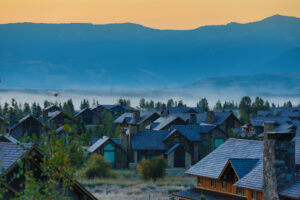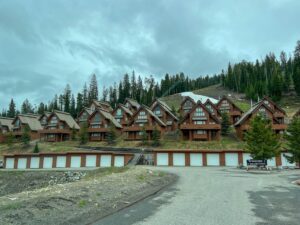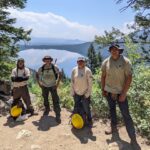Skyrocketing housing prices drive residents out of desirable outdoor recreation communities
By Kristen Pope
Jackson, Wyoming, is famous for its amazing outdoor access, but finding an affordable place to live there is a perpetual struggle. “We know that housing [in Jackson] is very expensive and it’s out of reach for most of our seasonal and younger workers who are less established in their careers,” says April Norton, director of the Jackson/Teton County Affordable Housing Department. In Jackson, the median sale price of a single-family home in 2022 was $3.5 million, a record high for the community. Due to the high cost and shortage of housing, as many as 40 percent of local workers live outside the county and make lengthy commutes, sometimes on icy, snow-packed roads in nearly white-out conditions. During the busy summer season, some live out of their vehicles on nearby public lands. Other long-term residents have simply moved away.
And Jackson is not alone. For many small mountain towns, the very features that attract people also make them challenging and expensive places to live. Communities throughout the West endowed with natural amenities—nearby forests, mountains, trails, beaches, and wildlife—are seeking ways to capitalize on the economic opportunities that come with outdoor recreation and tourism. At the same time, they strive to avoid sacrificing the characteristics, such as quiet trails and little traffic, that make these places so desirable to live in the first place.
Researchers from Headwaters Economics, an independent, nonprofit research group, explored the challenges communities like Jackson face, along with potential solutions, in a recent report entitled The Amenity Trap: How high-amenity communities can avoid being loved to death.
The term “amenity trap” describes “a place with natural attractions that make it a great place to live but also threaten it,” as throngs of tourists strain local infrastructure while short-term rentals and wealthy residents, including part-time residents, drive up housing costs for local workers. So, what can communities do to escape the trap? The report authors offer a range of solutions and examples that communities can consider to provide more affordable housing for local workers.
~
The housing crisis, in both affordability and availability, is a nationwide problem, but a few factors make it especially acute in outdoor-oriented communities throughout the Mountain West. Located in rural areas with great outdoor access, these towns are generally considered nice places to live, where people can admire gorgeous scenery and embrace an active lifestyle that may involve skiing a few laps or going for a trail run on their lunch break. Those qualities also attract people looking for second homes, remote workers, and tourists, all of whom compete with locals for limited housing.
And the competition is stiff. Wealthy individuals may purchase second (or additional) homes in cash, making their offers more attractive and higher than those from people relying on mortgages, which generally cannot extend above a house’s appraised value. Limited buildable land and a limited labor force also make housing problems especially pronounced in some outdoor amenity communities.
This housing shortage detracts from quality-of-life for residents and can even imperil their ability to remain housed. The Amenity Trap report cited a 2020 study saying median rent increasing by $100 per month is associated with homelessness rising by 9 percent. A 2022 Teton Region Housing Needs Assessment survey found nearly half of renters in the region who chose to complete the survey had been forced to move in the past three years, often more than once, due to factors like their residence being sold or converted to a short-term rental or a significant rent increase. When fewer properties are available for local workers to rent, this drives prices even higher.
“When communities have a deep toolbox to draw from, I think they can start to move the needle.” Megan Lawson
Many of Jackson, Wyoming’s, vital workers, including teachers, healthcare workers, snowplow drivers, and emergency responders, live outside the county or even across the state line in Idaho. Commuters can be stranded in inclement weather, and driving long distances every day isn’t cheap. The Teton Region Housing Needs Assessment found these commutes cost an average of $500-850 per month. And commuting negatively affects communities when those hours behind the wheel each day cut into time engaging with loved ones or participating in civic life.
“In the next five years, we need to build 2,000 housing units just in Teton County, Wyoming,” Norton says. And the number is almost double when considering the wider region, including Teton Valley, Idaho, and northern Lincoln County, Wyoming, she says. But finding a place for new structures is a challenge since 97 percent of the county is public land—mostly Grand Teton National Park and the Bridger-Teton National Forest. Of the 3 percent that is private land, several thousand acres are under conservation easement or other restrictions, leaving a very small footprint for building homes. The lack of housing availability is a factor that, coupled with soaring costs, has pushed many long-term residents to move away.

These problems echo around the Mountain West. In Big Sky, Montana, census data shows that 78 percent of Big Sky’s workforce now faces commutes of more than 40 miles. Further, many of the communities that Big Sky workers commute from also face housing stresses. The Big Sky Community Housing Trust reported the average cost to purchase a nonluxury condo at nearly $1.2 million. They also reported a 0 percent vacancy rate for long-term rentals at the end of 2022.
David O’Connor, the trust’s executive director, says a healthy vacancy rate would be closer to 5 or 6 percent, where market forces can impact rent levels. “So probably the greatest impact of a 0 percent vacancy rate is unfettered growth in rental rates,” he says. “There just is no throttle then to try and keep those rates down because from the perspective of the market, demand is then infinite and supply is not, so it’s just basic economics and the price goes up.”
Communities can be reactive and try to stop growth, do nothing and wait, or be proactive and plan ahead. According to the Amenity Trap report authors, trying to restrict growth by methods such as limiting building permits can have unintended consequences like driving up the cost of available housing.
“When communities are faced with change, it’s very understandable to want to put the brakes on, but what we’ve seen is that it doesn’t affect the attractiveness of your community, it doesn’t affect the desirability, and people still want to come there,” says Megan Lawson, economist at Headwaters Economics and co-author of the report.
~
The Amenity Trap report describes a range of tools communities can consider to address housing for local residents. “With all the different strategies that communities are using around housing, there’s no single program or policy that’s going to solve the housing challenges these places are facing,” Lawson says. “But I think … when communities can try, can have a deep toolbox to draw from, I think they can start to move the needle .”
One strategy is to make more rental units available to local workers, including by incentivizing homeowners to rent to local workers. Durango, Colorado, offered “ADU amnesty” to legalize existing unpermitted “accessory dwelling units” such as apartments above garages and in backyards. Now, Durango is incentivizing the construction of new ADUs by offering $8,000 rebates for a set number of ADUs that meet certain requirements, including the owner renting it to a local worker who uses the space as their primary residence, and committing to the program for two years.
Big Sky, Montana, provides financial incentives for homeowners to offer long-term (one- or two-year) rentals to locals, with higher amounts for homes that have more bedrooms to hold entire families. However, without guardrails these types of programs risk benefitting investors and second homeowners more than local residents. In a similar “Lease to Locals” program, Summit County, Colorado, had to cap the amount owners could charge renters after some set rates the local workforce generally couldn’t afford.
Limiting short-term vacation rentals is another way to make more homes available to local residents. Bozeman, Montana, uses zoning to restrict short-term rentals in certain neighborhoods. While such measures can increase available housing, they can also be controversial since they impact residents and businesses running short-term rentals as income sourc es. The Big Sky Community Housing Trust also provides local homeowners with cash incentives to put permanent deed restrictions on their properties that prohibit short-term rentals and specify occupants must work locally. Jackson, Wyoming, is working on a similar deed restriction program to ensure more homes are occupied by members of the permanent local workforce.
“It hits two birds with one stone,” Norton says of Jackson’s program. “It’s providing stable housing for someone who is working locally, but it’s also protecting community character, so we don’t have to build up bigger all the time. We can protect some of these cool funky houses in town, too, that have been workforce housing and hopefully will remain workforce housing.”

In some outdoor amenity communities, a few local businesses such as ski resorts provide employee housing for a limited number of employees. For example, Jackson Hole Mountain Resort offers limited housing for full-time employees including shared 4-bedroom, 2-bathroom apartments with no pets allowed and very limited parking. Another option is a shared motel room with two queen beds, one bathroom, and a mini fridge and microwave, but no kitchen. This motel is a 20–30-minute bus ride from the ski resort, and pets are not allowed. Vail Resorts also offers housing options for employees who don’t mind having roommates. In many communities, there are more people seeking employee housing than beds available.
Another approach communities can take is to build more houses, if land is available for construction. Jason Peasley, executive director of the Yampa Valley Housing Authority in Steamboat Springs, Colorado, says the housing issue has existed for more than 40 years and part of the solution is to increase housing supply. After an anonymous donor gave 534 acres of open land adjacent to Steamboat Springs for affordable housing, the Yampa Valley Housing Authority began planning the Brown Ranch project. The county’s current housing shortfall is 1,400 units, and the project includes plans to build 2,300 new homes by 2040. Neighborhoods will be built for affordability and sustainability, as well as connectivity and health equity.
“We can expand the size of our community to accommodate our workforce and make sure that those who work in Steamboat and want to live in Steamboat have that option,” Peasley says.
In another effort to create additional housing, the Big Sky Community Housing Trust is building RiverView Apartments, a federally-funded low-income housing apartment project scheduled to be ready in 2024.
The difficulty of creating additional housing spans beyond planning. It also requires people to physically build the structures for people to live in. A short supply of labor (as well as housing for laborers) compounds the housing challenge in many outdoor recreation communities. The Amenity Trap report discusses modular housing as a potential solution being used in parts of Colorado. Rather than requiring workers to spend weeks or months on-site building a home from the foundation up, modular homes are built in a centralized location, such as the Fading West factory in Buena Vista, Colorado, and then transported, installed, and finished in less time than building on-site. “Prefabricated and modular homes are typically not distinguishable from traditional stick-built houses and, importantly, must meet the same building code as stick-built homes,” the report states, adding that such homes can cost 10-20 percent less than homes built on-site.
Funding is another challenge that limits housing programs. Different communities turn to approaches like debt financing through bonds, which may rely on funding from local property taxes, and forming partnerships between public and private entities to spread out costs of housing solutions. Others focus on taxing tourism to help pay for housing programs and solutions. Steamboat Springs, Colorado, now charges a 9 percent tax on short-term rentals, which is estimated to bring in $11 million for affordable housing initiatives, including the Brown Ranch Project, over the next 20 years.
~
As communities already entrenched in challenging housing situations seek innovative solutions, other communities that are starting to develop their own outdoor recreation economies can plan ahead. Escaping the trap and addressing severe shortages of affordable homes requires, the report authors say, proactively creating comprehensive housing solutions ahead of or along with economic development plans, not after the fact. By learning from places like Jackson, Wyoming, and taking the lessons from the Amenity Trap report to heart, communities can create housing solutions in tandem with developing ways to boost their economies and enhance quality-of-life for residents and visitors alike. The report’s authors emphasize that each community is unique and will need its own set of tools to address its individual situation.
“The challenges around housing that communities are struggling with right now are not new,” says Lawson, but now there is “a much broader group of people who are interested and paying attention to our policies around housing.” She says as community members see more people affected by a lack of affordable housing, they are starting to understand how housing challenges affect their neighbors, local businesses, and other aspects of community. This sets the stage for community leaders to take action.
“I think the challenges are a lot more visible now, and that gives an opportunity for more voices at the table around changing our housing policies.”
Kristen Pope is a freelance writer who lives in the Tetons. Find more of her work at kepope.com.
Header image: Steamboat Springs, Colorado, (Steve Estvanik, Shutterstock).


